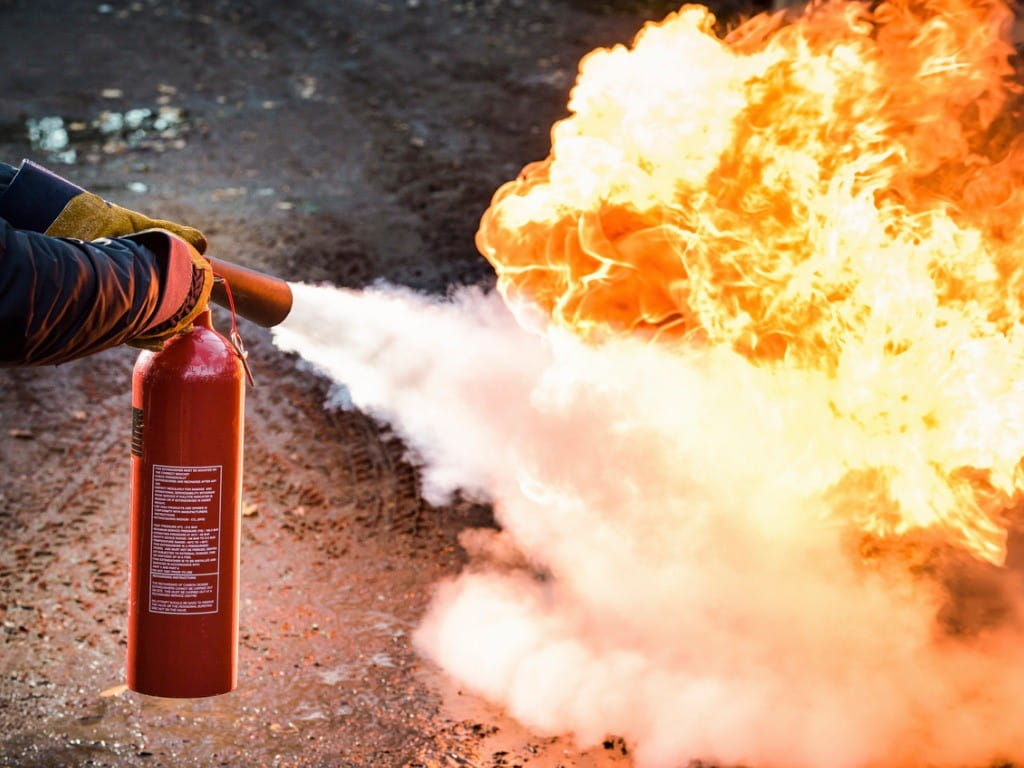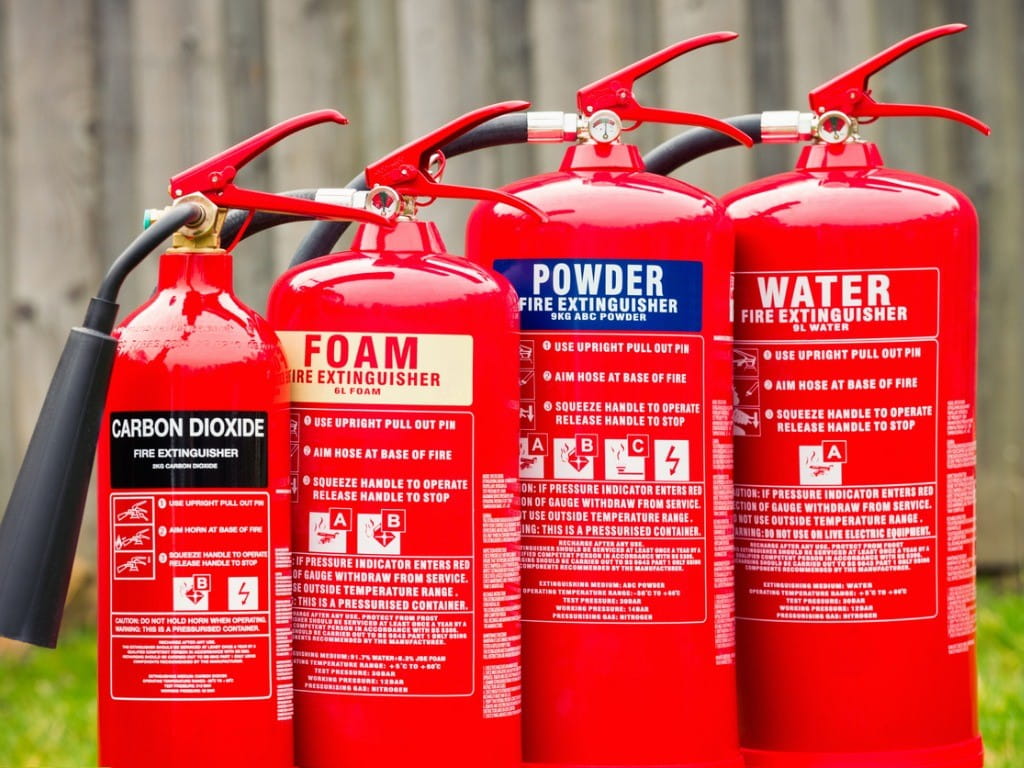 fighting a fire" />
fighting a fire" /> fighting a fire" />
fighting a fire" />
Proper use of fire extinguishers is generally safe; however, there is some risk for mild respiratory, skin, or eye irritation. Use in areas with poor air flow, use with intent to harm someone, or intentional inhalation of fire extinguishers can produce serious toxicity and would require medical evaluation.

Debate continues about when humans first started using fire, but controlling and extinguishing fires were natural developments shortly afterward. Fire extinguishing methods in ancient Egypt and Rome included use of hand water pumps and bucket brigades. Technology has advanced considerably to include other fire suppression techniques but still centers around removal of heat and/or oxygen from a fire and by interrupting the chemical reaction responsible for the fire. Today's portable fire extinguishers are pressurized canisters that release a variety of fire suppressants including powders, gases, and water. Most fire extinguishers should be operated using the PASS technique: P ull out the safety pin, A im the extinguisher at the base of the fire, S queeze the handle, and S weep the spray from side to side.
In the US, fires have five main classifications, and fire extinguisher ratings are based on the kind of fire they are intended to put out. Class A fires involve ordinary materials that easily burn, such as paper, cloth, and some plastics. Class B fires are from flammable liquids such as gasoline, non-cooking oils, solvents, and alcohols. Class C fires involve electrical equipment such as appliances, computers, and power tools that are plugged into a live/hot electrical outlet. Typical household fires are usually class A, B, or C. Class D fires involve combustible metals such as lithium, titanium, and zirconium and are associated with manufacturing facilities. Class K fires are due to cooking oils and grease used in deep fat fryers in commercial kitchens. This article will focus on portable fire extinguishers typically found in homes and offices.
Many fire extinguishers release a fine powder. The most common is the multipurpose dry chemical type, which is used for Class A, B, and C fires. These contain monoammonium phosphate, which comes out as a yellow powder. The yellow color helps to distinguish it from other non-multipurpose extinguishers. Ordinary dry chemical extinguishers are used for Class B and C fires only. They often contain sodium bicarbonate (baking soda), which comes out as a white powder.
Inhalation of monoammonium phosphate and sodium bicarbonate can cause mild irritation to the nose, throat, and lungs and results in symptoms like shortness of breath and coughing. Dizziness and headache are also possible. These symptoms usually resolve quickly with fresh air. Ongoing minor irritation often improves after a steam treatment, such as a steamy shower. People with lung conditions like asthma or someone deliberately sprayed at close range can have more serious respiratory effects and might need medical attention. Contact of these powders with the eyes, nose, throat, and skin can cause irritation, which should improve after rinsing the exposed area. Deliberate inhalation or ingestion can cause serious symptoms such as pneumonia, seizures, irregular heartbeat, and kidney failure. People with more than mild symptoms or anyone with a deliberate exposure should be managed in a healthcare facility.
Carbon dioxide (CO2) fire extinguishers are used for Class B and C fires. They emit pressurized CO2 gas, which smothers the fire by blocking the oxygen that the fire needs. Unlike the dry chemical types, this nonflammable gas quickly evaporates leaving nothing behind. Because the gas is under pressure, pieces of dry ice (solid CO2) might be emitted. CO2 is not to be confused with carbon monoxide. Carbon monoxide is a very toxic gas that is generated by burning fuels and can be produced by faulty gas appliances, car exhaust, and fires. CO2 is a naturally occurring gas and is part of the air we breathe. CO2 is also found in carbonated beverages. Toxicity from inhaled CO2 only occurs with very high concentrations. In most situations, there is enough oxygen in the area to prevent toxicity. However, toxicity can occur if a CO2 extinguisher is used in a small, poorly ventilated area. Inhalation of concentrated CO2 causes the same symptoms as not having enough oxygen, including difficulty breathing, dizziness, and loss of consciousness. Anyone exposed to concentrated CO2 should seek fresh air immediately. Medical attention would be needed for effects that do not resolve quickly or for anyone who loses consciousness. Direct contact of the skin with the pressurized CO2 can cause frostbite. The damage to the skin can be limited to mild redness, but blisters are also possible. Damage to the eyes can also occur with direct exposure.
If you suspect someone has inhaled spray from a fire extinguisher, get them to fresh air immediately. Exposure of the eyes or skin to any of the dry chemical fire extinguishers should be treated by immediate rinsing of the affected areas. After this initial treatment has been performed, check the webPOISONCONTROL ® online tool for guidance or call Poison Control at 1-800-222-1222.
Karen D. Dominguez, PharmD
Certified Specialist in Poison Information
Call 1-800-222-1222 or
Case 1. A school nurse called Poison Control because a child sprayed an ABC-rated fire extinguisher toward several students and teachers. Some of them had shortness of breath and coughing while others had nausea, headaches, or irritated eyes. Poison Control instructed the nurse to have everyone get fresh air and to rinse the eyes of anyone with redness or irritation. Poison Control determined that the extinguisher contained monoammonium phosphate and only mild, brief effects were anticipated. A follow-up call to the nurse was made later in the day, and the teachers and students were all OK.
Case 2. A 20-year-old man developed first- and second-degree frostbite injury to his right hand after using a CO2-containing fire extinguisher. His hand was in prolonged contact with the CO2 due to a leaky gas valve. The man needed treatment by a burn specialist.
Case 3. The following product review was noted on an online retailer website for an ABC-rated fire extinguisher. "I opened the package and was hit in the face with a cloud of yellow powder. This was my first fire Extinguisher purchase and I had no idea what the powder was so I called poison control and learned the thing had completely discharged in the package. I wish I had read the other reviews more carefully because it looks like this is not an uncommon occurrence with this…" Needless to say, the product only received a 1-star rating!